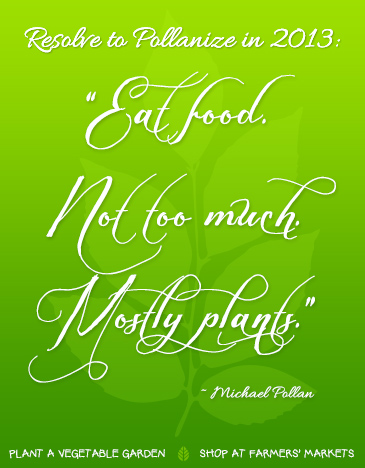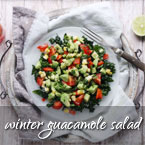Resolve to Pollanize in 2013
Reading the Michael Pollan’s The Omnivore’s Dilemma was a light-bulb-clicking-on experience.
I don’t readily jump on people’s bandwagons, but Pollan struck an immediate chord. At the time, I was already a devoted organic vegetable gardener, and needed no convincing that homegrown food tasted better. I just really had no idea of the depths to which Big Agriculture had sunk, in ethics, in practice, and in result.
Disgraceful, is probably the kindest word I can think to publish. It’s embarrassing that America is so far behind Europe in banning the completely unacceptable practices that Big Ag thrives on.
The Omnivore’s Dilemma was my introduction to industrial agriculture. And it’s been a life-changer. If you’re looking for a good read, I recommend it. It’s not a hard-core, fist-pumping monologue, but rather a thoughtful, reasoned investigation into our food system.
Here’s the food gospel I hope to spread for 2013:

Small steps. That’s all you need to do. Here are my suggestions for 2013. Pick a few below; try ‘em out. See what fits with your lifestyle. Small changes today add up.
- Cook more meals at home. This is a toughy, I know. If you’re overwhelmed by all the foodie-food-blogger-hype on the web, just turn away from it. (Sometimes, it’s too much for me and I have a food blog – soupaddict.com). You don’t need to cook a 3-course-meal on a crazy Wednesday night. Heck, I *never* cook three-course meals. It’s all about simplifying, not … well … complexifying. Stir-fries are wonderfully simple, and healthy to boot (in the dead of winter, don’t hesitate to use frozen vegetables — they’re quite healthy). One of my all-time favorite meals is still spaghetti (I use whole grain or Einkorn pasta) with a simple pasta sauce, topped with veggie meatballs or veggies sausages. Total comfort on a plate — dinner on the table in 20 minutes. And soup. So easy, so forgiving. So left-over-scraps-friendly. Pick one or two nights a week, and resolve to cook. Forgive yourself if you slip, and pick up again next week. Just cook.
- Start a garden. You don’t need huge tracks of land. In college, I grew tomatoes and peppers on the balcony of my one-bedroom apartment. My east facing (read, sucky sunlight availability) balcony. There’s a ton of info on container gardening on the Interwebs: a quick search will get you started. If you have room on your lawn, dig a small space and plant your favorite vegetable. You don’t need to start big (unless you want to). Just start.
- Grow an herb garden. Even easier. Herbs are wonderfully flexible and forgiving. They grow marvelously in the ground, in pots on the deck, in pots on your windowsill. It’s January, and cilantro, rosemary, tarragon, flat-leaf parsley, thyme, and sage are still growing strong in my neck of the woods. Even if you’re not that much into cooking, sprinkling some from fresh rosemary over a baked potato — or tarragon on scrambled eggs, thyme on soup, sage on pasta — makes a world of difference. Pick your favorite, and try it.
- Shop at farmers’ markets. The farmers’ market boom is still going strong. Do some research on the Interwebs — there might be farmers’ markets in your area that you never heard of (market advertising budgets are usually quite slim and rely on word-of-mouth). If you’re worried about the expense, no problem. Remember, small steps. Buy your favorite vegetables from the farmers’ market; the rest, from the grocery. I recommend tomatoes — far, far, far superior to grocery store tomatoes. So much so, you’ll never eat another grocery store tomato again.
- Find a CSA. Even in areas that don’t have formal farmers’ markets, it’s likely you’ll be able to find a CSA. The way a Community Supported Agriculture works is that you pay a specified amount to a farmer upfront, at the beginning of the season (so, now, in January, is a great time to find openings), and throughout the growing season, you’re guaranteed to receive a share of the farmer’s harvest (usually weekly). (Note that you do assume some risk with a CSA – if the farm incurs a catastrophe, such as wind damage from a strong storm, and has no harvest at a particular time, you’ll receive nothing. However, farmers generally grow a wide variety of vegetables, so, wind that destroyed tomato plants may have not even touched low-growing butternut squash.) You’ll benefit from both the fresh produce and the relationship with the farmer (what an opportunity, to be able to shake the hand of the person who grows the food you feed your family).
- Buy organic at the grocery, when you can. Organics is not about enhanced nutrition, it’s about keeping pesticides out of you and your loved ones. Food science is only beginning to scratch the surface of the long-term health effects of the crazy-strong pesticides and herbicides that Big Ag uses on their crops. Do what you can for your family. The best bang for the organic buck? Thin-skinned fruits and vegetables, like apples, tomatoes, potatoes, celery, and berries — produce whose skins are an ineffective barrier against sprays of pesticides and herbicides
Interested in learning more about our food system? Here are some great winter reads:
- The Omnivore’s Dilemma
(by Michael Pollan)
- In Defense of Food: An Eater’s Manifesto
(by Michael Pollan)
- Tomatoland: How Modern Industrial Agriculture Destroyed Our Most Alluring Fruit
(by Barry Estabrook)
- The American Way of Eating: Undercover at Walmart, Applebee’s, Farm Fields and the Dinner Table
(by Tracie McMillan)
- What to Eat
(by Marion Nestle)
- Animal, Vegetable, Miracle: A Year of Food Life
(by Barbara Kingsolver)













Comments are closed.